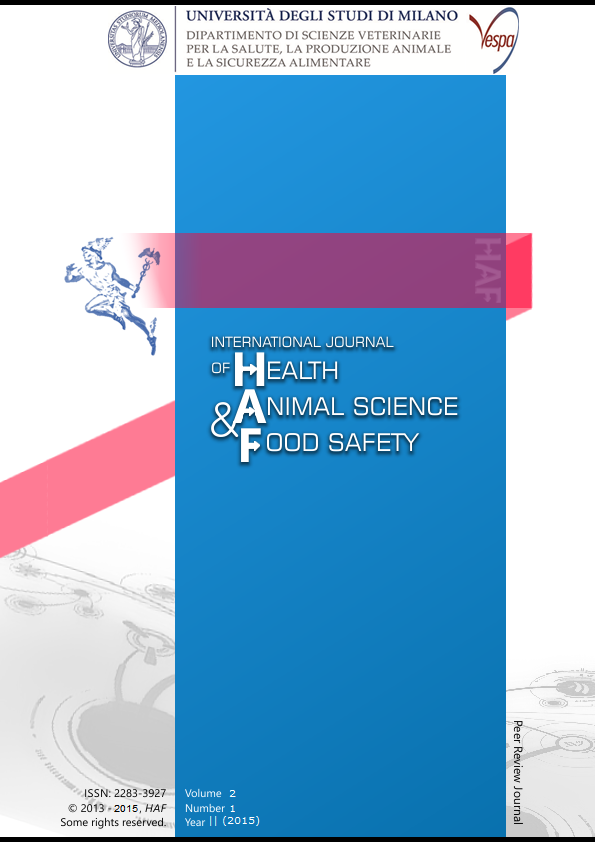Abstract
Anthrax is caused by the organism Bacillus anthracis. The organism is globally occurring and epidemics are reported the world over. It is an important infectious disease of domestic animals and can survive harsh conditions that would otherwise be drastic for other microorganisms. To date, no outbreak has been reported in the Pacific Island region except Australia and New Zealand where B. anthracis has been isolated from livestock. Papua New Guinea has had sporadic (reported) instances of anthrax outbreak, but has not been scientifically established. It is still unclear if the anthrax causing organism is present in the environment or wildlife in the country. It remains to be so until scientific evidence becomes available. This article aims to review scientific evidence of anthrax in the country.
Riferimenti bibliografici
Administration USFAD: FDA approves raxibacumab to treat inhalational anthrax. In: First monoclonal antibody approved using the Animal Efficacy Rule. New Hampshire. 2012.
Alla M.B.W., Mohamed T.E, Abdelgadir A.E., 2011. Detection of antibiotics residues in beef in Ghanawa Slaughterhouse, Khartoum State, Sudan. African Journal of Food Science. 5 (10): 574–580.
Animal Health Australia (2005). Disease strategy: Anthrax (Version 3.2).
Australian Veterinary Emergency Plan (AUSVETPLAN), Edition 3, Primary Industries Ministerial Council, Canberra, ACT.
Brooks, Butel, Ornston: Medical Microbiology, 19th edn: Appleton; 1991: 180-182
Bush L. M., Abrams B.H., Beall A., Johnson C.C. Index case of fatal inhalational anthrax due to bioterrorism in the United States. The New England Journal of Medicine 2001.
Caledonia IPN, Community SotP, Organization WH: Anthrax, Generic guidlines for the Pacific Islands. 2002.
Cheeesborough M. District laboratory Practise in Tropical Countries, Part 2. Cambridge: Cambridge University Press. 2000: 37-43
Durrheim D.N., Freeman P., Roth I., Hornitzky M. EpidemiologicQuestions fromAnthrax Outbreak,Hunter Valley, Australia. Emerging Infectious Diseases. 2009, 15(5): 3.
Ebrahimi C.M., Sheen T.R., Renken C.W., Gottlieb. RA: Contribution of Lethal Toxin and Edema Toxin to the Pathogenesis of Anthrax Meningitis. Infection and Immunity. 2011, 79(7): 2510–2518.
Edwards K. A., Clancy H. A., Baeumner A.J. Bacillus anthracis: toxicology, epidemiology and current rapid-detection methods. Analytical and Bioanalytical Chemistry. 2005, 384(1): 73-84.
Evers M., Robinson S: Anthrax vaccination in NSW. In: Prime Facts. 3 edn. NSW. 2009
Fasanella A., Garofolo G. MHJ: Anthrax undervalued zoonosis. Veterinary Microbiology. 2008, 140(3-4): 318-31.
Gill J. Anthrax - Still history after all these years. Surveillance 1993, 20(1): 21-22.
Hide R. Pig Husbandry in New Guinea. In Canberra, 2003: pp 307.
Horwood P., Greenhill A. Cholera in Papua New Guinea and the importance of safe drinking water sources and sanitation. WPSAR 2012, 3(1): 1-3.
Jernigan J.A., Stephens D.S., Ashford D.A., Omenaca C. Bioterrorism-Related Inhalational Anthrax: The First 10 Cases Reported in the United States. Emerging Infectious Diseases. 2001, 7(6): 12.
Macfarlane D. Country Pasture/Forage Resource Profiles Papua New Guinea. FAO 2009.
Massachusetts Department of Public Health BoCDC: Guide to Surveillance, Reporting and Control of Anthrax. 2006: 11.
Missiakas D.M. Bacillus anthracis and the Pathogenesis of Anthrax. Biological Weapons Defense Infectious Disease. 2005: 79-97.
Muller H. J. Australia and New Zealand Standard Diagnostic Procedure. 2010: 15.
Murray, Drew, Kobayashi, Thompson. Medical Microbiology, vol. 1, International Student Edition edn: Mosby; 1990: 180-183
Prevention CfDCa. Guidelines for the Treatment of Anthrax. In: CDC 24/7: Saving Lives Protecting People™. Atlanta: Centers for Disease Control and Prevention 2014.
Price E.P., Seymour M.L., Sarovich D.S., Latham J., Wolken S.R., Mason J., Vincent G., Drees K.P., Stephen M., Beckstrom-Sternberg, Adam M. Phillippy et al. Molecular Epidemiologic Investigation of an Anthrax Outbreak among Heroin Users, Europe. Emerg Infectious Disease 2012.
Provet. Anthrax. In Provet Healthcare Infromation. Provet; 2013.
Quinn C.P., Dull P.M., Semenova V., Li H. Immune Responses to Bacillus anthracis Protective Antigen in Patients with Bioterrorism-Related Cutaneous or Inhalation Anthrax. The Journal of Infectious Diseases. 2004: 190-199.
Schaechter M., Ingraham J., Neidhardt, Microbe. F. Bacillus anthracis. In Microbe Wiki. Edited by Ucar G., Pogliano K., Holzhauer D. Washington DC: ASM Press; 2006.
Sherer K., Li Y., Cui X., Eichacker P.Q. Lethal and Edema Toxins in the Pathogenesis of Bacillus anthracis Septic Shock Implications for Therapy - Critical Care Perspective. Am J Respir Crit Care Med. 2007, 175: 211–221.
Spencer R.C. Bacillus anthracis. J Clin Pathol. 56:182-187.
Stoltenow C.L., Hugh-Jones M. Anthrax. Christian Veterinary Mission 2010, 33(3): 9.
Todar K. Bacillus anthracis and Anthrax. In: Todar's Online Textbook of Microbiology. 2012.
Turnbull W.B.. PCB: Anthrax in animals. Molecular Aspects of Medicine 2009, 30: 9.
Turnbull, Böhm, Cosivi, Doganay, Hugh-Jones, Joshi, Lalitha, de Vos. Guidelines for the Surveillance and Control of Anthrax. In Humans and Animals. World Helth Organization. 1998, pp: 97.
Turner A.J., Galvin J.W., Rubira R.J., Condron R.J., Bradley. T: Experiences with vaccination and epidemiological investigations on an anthrax outbreak in Australia in 1997. Journal of Applied Microbiology. 1999, 87(2): 294-297.
Tweet. Preventing Anthrax in Livestock, Hobby Farms. 27 August 2010.
Veterinary Services AHA. Australian Veterinary Emergency Plan. 2012.
Vyas J.M.. Anthrax. In Medline Plus. Massachusetts: U.S. National Library of Medicine. 2013
Williams A.A., Parashar U. D., Stoica A., Ridzon. R: Bioterrorism-Related Anthrax Surveillance, Connecticut, September–December, 2001. Emerging Infectious Diseases. 2002, 8(10): 5.
World Health Organization. Anthrax in humans and animals. In 4 ed. Geneva: WHO Press, 2008.
World Health Organization. B051 - Anthrax. In World Health Organization, Guidelines for the Surveillance and Control of Anthrax in Humans and Animals.
This work is licensed under a CC BY-SA 4.0 international

